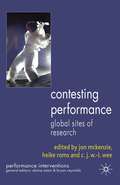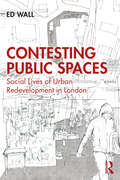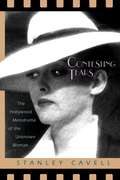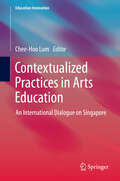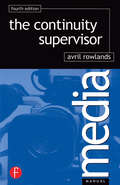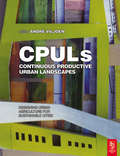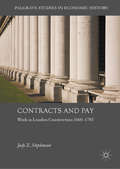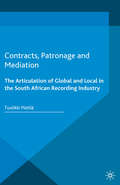- Table View
- List View
Contesting Performance: Global Sites of Research (Performance Interventions)
by J. McKenzie H. Roms C. WeeContesting Performance is a collection of essays by international scholars that addresses the global development of performance research in the late twentieth and early twenty-first centuries. The collection functions as a critical reader on diverse approaches to studying performance that contest dominant paradigms of performance studies.
Contesting Public Spaces: Social Lives of Urban Redevelopment in London
by Ed WallThis book explores concerns for spatial justice as streets, squares, and neighbourhoods are continuously made and remade through planning processes, political ambitions and everyday activities. By investigating three sites in London that have been the focus of masterplanning, Ed Wall exposes conflicts between planning offices and private developers who direct large urban change and community groups, market traders and residents whose public lives are inseparable from their neighbourhoods being reconfigured. The book uniquely brings sociological approaches to what are often considered architectural concerns, revealing challenges as London's public spaces are designed, regulated and lived. Through in-depth research, Ed Wall identifies how uncertainty caused by large-scale urban strategies, the realisation of visual priorities, and uneven relations between private interests, public organisations and daily lives determine the public realm of global cities. This work is intended for readers interested in how the urban spaces of their cities are continually produced in competing ways—from architecture and urban studies scholars to planners and politicians.
Contesting Public Spaces: Social Lives of Urban Redevelopment in London
by Ed WallThis book explores concerns for spatial justice as streets, squares, and neighbourhoods are continuously made and remade through planning processes, political ambitions and everyday activities. By investigating three sites in London that have been the focus of masterplanning, Ed Wall exposes conflicts between planning offices and private developers who direct large urban change and community groups, market traders and residents whose public lives are inseparable from their neighbourhoods being reconfigured. The book uniquely brings sociological approaches to what are often considered architectural concerns, revealing challenges as London's public spaces are designed, regulated and lived. Through in-depth research, Ed Wall identifies how uncertainty caused by large-scale urban strategies, the realisation of visual priorities, and uneven relations between private interests, public organisations and daily lives determine the public realm of global cities. This work is intended for readers interested in how the urban spaces of their cities are continually produced in competing ways—from architecture and urban studies scholars to planners and politicians.
Contesting Tears: The Hollywood Melodrama of the Unknown Woman
by Stanley CavellWhat is marriage? Can a relationship dedicated to equality, friendship, and mutual education flower in an atmosphere of romance? What are the paths between loving another and knowing another? Stanley Cavell identified a genre of classic American films that engaged these questions in his study of comedies of remarriage, Pursuits of Happiness. With Contesting Tears, Cavell demonstrates that a contrasting genre, which he calls "the melodrama of the unknown woman," shares a surprising number and weave of concerns with those comedies. Cavell provides close readings of four melodramas he finds definitive of the genre: Letter from an Unknown Woman, Gaslight, Now Voyager, and Stella Dallas. The women in these melodramas, like the women in the comedies, demand equality, shared education, and transfiguration, exemplifying for Cavell a moral perfectionism he identifies as Emersonian. But unlike the comedies, which portray a quest for a shared existence of expressiveness and joy, the melodramas trace instead the woman's recognition that in this quest she is isolated. Part of the melodrama concerns the various ways the men in the films (and the audiences of the films) interpret and desire to force the woman's consequent inaccessibility. "Film is an interest of mine," Stanley Cavell has written, "or say a love, not separate from my interest in, or love of, philosophy." In Contesting Tears Cavell once again brilliantly unites his two loves, using detailed and perceptive musings on melodrama to reflect on philosophical problems of skepticism, psychoanalysis, and perfectionism. As he shows, the fascination and intelligence of such great stars as Ingrid Bergman, Bette Davis, and Barbara Stanwyck illuminate, as they are illuminated by, the topics and events of these beloved and enduring films.
Context: Architecture and the Genius of Place (Architectural Design Primer)
by Eric ParryDemonstrates how a building's setting should inform and inspire rather than constrain architectural design Context-Architecture and the Genius of Place is a highly engaging, informative discussion of context in architectural theory and practice. Eric Parry, one of the UK's most highly regarded architects — whose work has been widely lauded for its innovative response to its setting — addresses the contemporary definition of context and its importance for sustainable everyday living and urban design. Looking beyond the formal agenda to explore the fundamentals that give new social and cultural perspective to this vital point of departure for designers, this book turns the urban statistician's telescopic focus on global trends inside out for a better understanding of the cultural and physical conditions that make archetypes like the Parisian Café, the London High Street, the Baltic City Square, and the Mumbai Market part of the architect's lexicon. From pavement to landscape, readers will examine how context must be taken into account at every stage in the design process. This book draws on the author's extensive experience within complex urban settings to show how the existing fabric and social conditions can provide an essential starting point for new design, offering a framework for thinking about design responses and their relationship to cultural origins of place. Discover the importance of orientation Develop a sequential understanding of urban space Hear the dialogue between parts within a whole Differentiate the uses of formal and informal Whereas existing urban settings, particularly historic city centers, are generally regarded as limiting to architectural creativity, this book presents context as grounds for inspiration rather than constraint. When used correctly, these techniques create the feeling that a new building has always been there, simply because it "fits". Context explains the methods behind brilliant architecture, helping designers create buildings that not only belong, but can provide a catalyst to urban life.
Context: Architecture and the Genius of Place (Architectural Design Primer)
by Eric ParryDemonstrates how a building's setting should inform and inspire rather than constrain architectural design Context-Architecture and the Genius of Place is a highly engaging, informative discussion of context in architectural theory and practice. Eric Parry, one of the UK's most highly regarded architects — whose work has been widely lauded for its innovative response to its setting — addresses the contemporary definition of context and its importance for sustainable everyday living and urban design. Looking beyond the formal agenda to explore the fundamentals that give new social and cultural perspective to this vital point of departure for designers, this book turns the urban statistician's telescopic focus on global trends inside out for a better understanding of the cultural and physical conditions that make archetypes like the Parisian Café, the London High Street, the Baltic City Square, and the Mumbai Market part of the architect's lexicon. From pavement to landscape, readers will examine how context must be taken into account at every stage in the design process. This book draws on the author's extensive experience within complex urban settings to show how the existing fabric and social conditions can provide an essential starting point for new design, offering a framework for thinking about design responses and their relationship to cultural origins of place. Discover the importance of orientation Develop a sequential understanding of urban space Hear the dialogue between parts within a whole Differentiate the uses of formal and informal Whereas existing urban settings, particularly historic city centers, are generally regarded as limiting to architectural creativity, this book presents context as grounds for inspiration rather than constraint. When used correctly, these techniques create the feeling that a new building has always been there, simply because it "fits". Context explains the methods behind brilliant architecture, helping designers create buildings that not only belong, but can provide a catalyst to urban life.
Context and Narrative in Photography (Basics Creative Photography)
by Maria Short Sri-Kartini Leet Elisavet KalpaxiHowever beautiful or technically dazzling your photographs might be, if they don't tell a story, convey an idea or make your viewer stop and think, they are unlikely to make a lasting impression.Context and Narrative in Photography introduces practical methods to help you plan, develop and present meaningful, communicative images. With dozens of examples from some of the world's most thought-provoking photographers, this is a beautiful introduction to a fascinating aspect of photography.Beginning with an exploration of different narrative techniques, you'll be guided through selecting and developing a compelling concept for your project and how it might be conveyed either through a single image or a series of photographs. You'll also learn ways to incorporate signs, symbols and text into your work and how to present the finished piece to best reach your audience.New to this edition are extended projects, additional exercises and discussion questions, expanded case studies, around 25% of the images and an expanded Chapter 6 on integrating text into photographic projects.
Contexts for Music Learning and Participation: Developing and Sustaining Musical Possible Selves
by Susan Hallam Maria Varvarigou Andrea CreechThis book sets out a contemporary perspective on music education, highlighting complex intersections between informal, non-formal and formal practices and contexts. At a time when the boundaries between music learning and participation are increasingly blurred, this volume is distinctive in challenging a ‘siloed’ approach to understanding the diverse international music education landscape. Instead, the book proposes a multi-layered continuum of practices that can be applied across a range of formal, informal or non-formal concepts to support the development of musical possible selves. It challenges existing conceptions of learning in music education in part by drawing on research in adult learning, but also by considering the contexts in which learning takes place, and the extent to which this learning can be classified as formal, informal or non-formal.
Contextual Design: Defining Customer-Centered Systems (Interactive Technologies)
by Karen Holtzblatt Hugh BeyerThis book introduces a customer-centered approach to business by showing how data gathered from people while they work can drive the definition of a product or process while supporting the needs of teams and their organizations. This is a practical, hands-on guide for anyone trying to design systems that reflect the way customers want to do their work. The authors developed Contextual Design, the method discussed here, through their work with teams struggling to design products and internal systems. In this book, you'll find the underlying principles of the method and how to apply them to different problems, constraints, and organizational situations.Contextual Design enables you to+ gather detailed data about how people work and use systems + develop a coherent picture of a whole customer population + generate systems designs from a knowledge of customer work+ diagram a set of existing systems, showing their relationships, inconsistencies, redundancies, and omissions
Contextual Design: Design for Life (Interactive Technologies)
by Karen Holtzblatt Hugh BeyerContextual Design: Design for Life, Second Edition, describes the core techniques needed to deliberately produce a compelling user experience. Contextual design was first invented in 1988 to drive a deep understanding of the user into the design process. It has been used in a wide variety of industries and taught in universities all over the world. Until now, the basic CD approach has needed little revision, but with the wide adoption of handheld devices, especially smartphones, the way technology is integrated into people's lives has fundamentally changed. Contextual Design V2.0 introduces both the classic CD techniques and the new techniques needed to "design for life", fulfilling core human motives while supporting activities. This completely updated and revised edition is written in a clear, informal style without excessive jargon, and is the must-have book for any UX Design library. Users will find coverage of mobile devices and consumer and business products, all illustrated with new examples, case studies, and discussions on how to use CD with the agile development and other project requirements methods. - Provides tactics on how to gather detailed data on how people live, work, and use products - Helps develop a coherent picture of a whole user population - Presents tactics on how to use the seven "Cool Concepts" to support core human motives and generate new product concepts guided by user data, ideation techniques, and principles key to producing a compelling user experience - Explains how to structure the system and user interface to best support the user across place, time, and platform
Contextualized Practices in Arts Education: An International Dialogue on Singapore (Education Innovation Series)
by Chee-Hoo LumThis edited book not only makes a much-needed contribution to research in arts education but also provides a strong grounding of evidential support for Singapore arts education, in contrast to the current state of affairs in arts education in many parts of the world where severe cuts in funding, lackluster support for the arts and imperialist agendas are pervasive. The case of and for Singapore – presented in this edited book through rich descriptions of the dedicated, contextualized practices of arts educators, artists and researchers – offers readers many valuable lessons and reflections on the continued survival and advancement of arts education.
The Contingency of Necessity: Reason and God as Matters of Fact (New Perspectives In Ontology Ser.)
by Tyler TrittenRethinks cinematic journeys through history, globalisation, form and genre
Continuity Supervisor
by Avril RowlandsThe Continuity Supervisor is a practical guide to the basics of continuity, designed to be of use both to the newcomer and those more experienced. Formerly titled 'The Continuity Handbook: a guide for single-camera shooting, this new edition covers the latest technological changes which affect the Continuity Supervisor. Avril Rowlands worked at the BBC for any years as a PA. She has been involved in specialised training for the television industry and major film and television colleges. Her highly acclaimed residential courses attract students from major television companies worldwide. She is also a writer and independent television producer.
Continuity Supervisor
by Avril RowlandsThe Continuity Supervisor is a practical guide to the basics of continuity, designed to be of use both to the newcomer and those more experienced. Formerly titled 'The Continuity Handbook: a guide for single-camera shooting, this new edition covers the latest technological changes which affect the Continuity Supervisor. Avril Rowlands worked at the BBC for any years as a PA. She has been involved in specialised training for the television industry and major film and television colleges. Her highly acclaimed residential courses attract students from major television companies worldwide. She is also a writer and independent television producer.
Continuous Productive Urban Landscapes: Designing Urban Agriculture For Sustainable Cities
by Andre Viljoen Katrin Bohn Joe HoweThis book on urban design extends and develops the widely accepted 'compact city' solution. It provides a design proposal for a new kind of sustainable urban landscape: Urban Agriculture. By growing food within an urban rather than exclusively rural environment, urban agriculture would reduce the need for industrialized production, packaging and transportation of foodstuffs to the city dwelling consumers. The revolutionary and innovative concepts put forth in this book have potential to shape the future of our cities quality of life within them. Urban design is shown in practice through international case studies and the arguments presented are supported by quantified economic, environmental and social justifications.
Continuous Productive Urban Landscapes
by Andre Viljoen Joe HoweThis book on urban design extends and develops the widely accepted 'compact city' solution. It provides a design proposal for a new kind of sustainable urban landscape: Urban Agriculture. By growing food within an urban rather than exclusively rural environment, urban agriculture would reduce the need for industrialized production, packaging and transportation of foodstuffs to the city dwelling consumers. The revolutionary and innovative concepts put forth in this book have potential to shape the future of our cities quality of life within them. Urban design is shown in practice through international case studies and the arguments presented are supported by quantified economic, environmental and social justifications.
Contract Administration: RIBA Plan of Work 2013 Guide
by Ian DaviesThe RIBA Plan of Work 2013 Guide: Design Management is part of a brand new series providing must-read practical guidance to running efficient and successful projects using the new RIBA Plan of Work 2013. Each guide takes a core project task – in this case the role of the Contract Administrator - and explains the essential activities and considerations required at each stage of the new Plan of Work. Easy to use and navigate and in a small and handy format these guides will provide the ultimate quick reference support at your desk or on site. The author provides concise and pragmatic advice rooted in real world experience – a ‘how to’ that will resonate with practitioners. In-text features such as ‘hints and tips’, ‘checklists’, ‘forms and templates’ and ‘signposts’ to trusted resources will provide user-friendly support. Boxed examples will highlight best practice and illuminate common problems and solutions borne of hard won experience.
Contract Administration: RIBA Plan of Work 2013 Guide
by Ian DaviesThe RIBA Plan of Work 2013 Guide: Design Management is part of a brand new series providing must-read practical guidance to running efficient and successful projects using the new RIBA Plan of Work 2013. Each guide takes a core project task – in this case the role of the Contract Administrator - and explains the essential activities and considerations required at each stage of the new Plan of Work. Easy to use and navigate and in a small and handy format these guides will provide the ultimate quick reference support at your desk or on site. The author provides concise and pragmatic advice rooted in real world experience – a ‘how to’ that will resonate with practitioners. In-text features such as ‘hints and tips’, ‘checklists’, ‘forms and templates’ and ‘signposts’ to trusted resources will provide user-friendly support. Boxed examples will highlight best practice and illuminate common problems and solutions borne of hard won experience.
The Contractors
by Mr John B KeaneThis is the story of Dan Murray, who emigrated to England in 1952. He finds work as a building labourer and in time he becomes a building contractor.John B. Keane captures the turbulent, bawdy, anarchic life of Irish contractors and labourers as they try to make it big in England. Told in his usual hilarious and bulls-eye accurate style.
Contracts and Pay: Work in London Construction 1660–1785 (Palgrave Studies in Economic History)
by Judy Z. StephensonThis book presents a new economic history of London construction in the early modern period. Drawing on extensive archival material from key sites such as St Paul’s Cathedral and London Bridge, it describes the organization of contracts and work on large-scale ‘extraordinary’ projects and maintenance contracts in the city during a key period of architectural and organizational development in Britain. Stephenson shows that the organisation of the industry and the welfare of its workers were shaped by the contracts and finance of large institutions and ambitious businessmen. Providing fresh wage and earnings data for craftsmen and labourers during the period, it offers new material and debate for economic, business and construction historians.
Contracts, Patronage and Mediation: The Articulation of Global and Local in the South African Recording Industry (Pop Music, Culture and Identity)
by Tuulikki PietiläThis book studies the long-term developments in the South African recording industry and adds to the existing literature an understanding of the prevalence of informal negotiations over rights, rewards and power in the recording industry. It argues that patronage features often infiltrate the contractual relationships in the industry.
Contractual Correspondence for Architects and Project Managers
by David ChappellThis book provides over 160 model letters, with commentary for use with all the main JCT 2005 building contracts. It concentrates on problems which can arise during a project, and draws on the author’s extensive experience as a contracts consultant. It is a companion to the author’s Standard Letters in Architectural Practice which covers more routine matters. The revised Fourth Edition takes account of: the 2005 editions of the JCT Standard Building Contract, the Intermediate Building Contract and the Minor Works Building Contract, both with their contractor’s design versions, ICD and MWD the 2004 updates of the Standard Form of Agreement for the Appointment of an Architect changes to case law since the last edition was published in 1996 It will be an invaluable guide for architects, building surveyors and project managers.
The Contradiction Between Form and Function in Architecture
by John Shannon HendrixContinuing the themes that have been addressed in The Humanities in Architectural Design and The Cultural Role of Architecture, this book illustrates the important role that a contradiction between form and function plays in compositional strategies in architecture. The contradiction between form and function is seen as a device for poetic expression, for the expression of ideas, in architecture. Here the role of the terms "form" and "function" are analyzed throughout the history of architecture and architectural theory, from Vitruvius to the present, with particular emphasis on twentieth-century functionalism. Historical examples are given from Ancient, Classical, Islamic, Christian, Byzantine, Gothic, Renaissance, Mannerist, and Neoclassical architecture, and from movements in the twentieth century to the present. In addition philosophical issues such as lineamenti, Vorstellung, différance, dream construction, deep structure and surface structure, topology theory, self-generation, and immanence are explored in relation to the compositions and writings of architects throughout history. This book contributes to the project of re-establishing architecture as a humanistic discipline, to re-establish an emphasis on the expression of ideas, and on the ethical role of architecture to engage the intellect of the observer and to represent human identity.
The Contradiction Between Form and Function in Architecture
by John Shannon HendrixContinuing the themes that have been addressed in The Humanities in Architectural Design and The Cultural Role of Architecture, this book illustrates the important role that a contradiction between form and function plays in compositional strategies in architecture. The contradiction between form and function is seen as a device for poetic expression, for the expression of ideas, in architecture. Here the role of the terms "form" and "function" are analyzed throughout the history of architecture and architectural theory, from Vitruvius to the present, with particular emphasis on twentieth-century functionalism. Historical examples are given from Ancient, Classical, Islamic, Christian, Byzantine, Gothic, Renaissance, Mannerist, and Neoclassical architecture, and from movements in the twentieth century to the present. In addition philosophical issues such as lineamenti, Vorstellung, différance, dream construction, deep structure and surface structure, topology theory, self-generation, and immanence are explored in relation to the compositions and writings of architects throughout history. This book contributes to the project of re-establishing architecture as a humanistic discipline, to re-establish an emphasis on the expression of ideas, and on the ethical role of architecture to engage the intellect of the observer and to represent human identity.
Contributions to a Computer-Based Theory of Strategies
by Nicholas V. FindlerPeople use the word strategy in a variety of different contexts. The term has connotations ranging from statesmanship to economic planning, and has become pervasive in the social sciences. We also talk about "problem solving strategies" and "corporate strategy" in a large business enterprise. The concept of strategy applies whenever a sequence of goal-oriented actions is based on large-scale and long-range planning. This monograph gives a systematic overview of the theory of strategies, a new area of enquiry developed over the past two decades by the author and his team. The projects described have clearly defined research objectives and are based on realistic assumptions about the environments in which the programming systems will work, and about the constraints and requirements they have to satisfy. Applications of the systems range over various aspects of air traffic control, automatic verification and validation of discrete-event simulation models, econometric model building, distributed planning systems for manufacturing, control of traffic lights, and others. The book is aimed at researchers, teachers and students in computer science, management science and certain areas of engineering. The reader should have some maturity in computer science and mathematics, and familiarity with the basic concepts of artificial intelligence.
